Introduction
 Linux Mint is one of the top free operating systems widely used in the world and currently receives the highest hits at DistroWatch.
Linux Mint is one of the top free operating systems widely used in the world and currently receives the highest hits at DistroWatch.
Even though it's an Ubuntu-based system, Linux Mint features only one panel at the bottom which looks closer to the taskbar in the traditional Windows system, and a well-organized start menu complete with a useful Search box. A select version also pre-installs some proprietary software such as necessary media codecs by default so that you play mp3, mp4 or most other media files with a player right away out of the box.
 Linux Mint 17 is a long-term service (LTS) release which will be supported until 2019 according to the developer.
Linux Mint 17 is a long-term service (LTS) release which will be supported until 2019 according to the developer.
The Cinnamon Edition of Linux Mint 17, 17.1 and 17.2 uses Cinnamon, instead of GNOME shell, as a user interface for the GNOME-3 desktop environment. And unlike Ubuntu Unity sporting a vertical launcher on the left side of the screen, Cinnamon maintains a traditional layout with a bottom panel and a Mint menu. If you're using this Edition, you might find these tips and tricks useful for working with the system on a PC.
Pin Programs to the Panel
Frequently used programs can be easily pinned to the panel.
- Browse to an application from the Menu.
- Right click an application, then select "Add to panel" (or drag an application and drop it to the panel launcher).
- Re-order the program icons on the panel launcher as you like by drag-and-drop.
Note: In the same way by right-clicking an application from the Menu, you can also add a program shortcut to the Desktop or the Favorites located at the left column inside Menu. The Favorites support drag-and-drop and re-ordering. See also "Enable Superbar".
Enable or Disable Applets on the Panel
An applet is a small tool or application which you can access directly from the panel for performing a task. Some applets have been enabled by default but you can disable the applets you don't need to use or enable the ones you like pretty easily:
- Right click an empty spot on the panel, select "Add applets to the panel".
- Right-click an applet to add or remove from the panel, then close the Applets window.
Note: You can also get more applets online from here, or in Linux Mint 17.1 and 17.2, go to System Settings > Preferences > Applets and click the "Available Applets (online)" tab.
Enable Superbar
In recent versions of Windows, frequently used programs can be pinned to the taskbar (hence called Superbar) for launching the programs and their icons are highlighted when the programs are running. Likewise, an applet called "Window List with App Grouping" can be added to the panel to achieve almost the same effect.
-
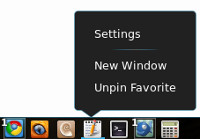 Download the applet Window List with App Grouping and unzip the file.
Download the applet Window List with App Grouping and unzip the file. - Copy the unzipped folder to ~/.local/share/cinnamon/applets.
- Follow the tip above to enable the applet "Window List with App Grouping".
- Right click the panel and switch on the Panel Edit mode.
- Drag the applet to the spot you like on the panel, then switch off the Panel Edit mode.
Note: Since this applet serves as a new launcher and the running programs are indicated, you can remove the applet "Window List" from the panel. To add a program shortcut to this new launcher, just drag a program from the Menu and drop it to the launcher, and you can pin or unpin programs from the panel as well with a simple right-click.
Set Preferences for the Mint Menu
Linux Mint has a Menu button where you can start doing things like running a program, looking for files, log out or quit the system and so on.
The Menu allows you to set your personal preferences with the steps below, for example:
- Right click "Menu", select "Configure".
- Replace Menu text to any other word when needed.
- If you wish, change the icon to another image file, for example, at /usr/lib/linuxmint/mintWelcome/icons/logo.svg. (Caution: avoid changing to a huge size image which might affect the panel.)
Note: In this Settings window, you can also set Menu hover delay and more.
Add a Program Shortcut from the Mint Menu
Quite often a shortcut is automatically added to the Menu when you install an application. But you might also download a program which requires you to manually add a shortcut for it to run from the Menu. This can be done without breaking a sweat.
- Right-click the Mint Menu, select "Configure" then "Open the menu editor".
- Click a software category for example Sound & Video under Applications.
- At the right panel, click "New Item".
- Type in a name for the application, for example, ClipGrab.
- To the right of "Command", browse to the application, for example the unzipped executable file, /home/username/Downloads/clipgrab-3.5.1-x86-64
- Click OK and Close buttons.
Note: If an executable file is not accessible, try to add permission to execute the file in the Terminal, for this example assuming the file is extracted to the "Downloads" folder:
cd ~/Downloads
chmod +x clipgrab-3.5.1-x86-64
Set a Fully Transparent Panel
When you select a theme from Menu > Cinnamon/System Settings > themes, the theme may come with a non-transparent or semi-transparent panel. But you can adjust the level of transparency for the panel if you like. For example, I've selected a Linux Mint theme and I can make it more transparent with the steps below. (Caution: changing the code incorrectly might result in a non-responsive desktop environment.)
- Press Alt-F2, type gksu gedit and press Enter.
- Browse to the folder /usr/share/themes/Linux Mint/cinnamon under "File System" and open this file cinnamon.css
- Search for a section beginning with #panel
- After the last line within the section, insert a new line for example background-color: rgba(0,0,0,0.35); (The alpha value ranges from 0 [full transparency] to 1 [full opacity].)
- Click Save and close the file.
- Switch to another theme and back to the Linux Mint theme to see the result.
Open Up a Window in Center (17 & 17.1)
Linux Mint 17.2 now supports opening a window in the center of the screen. If you're running an older version, Linux Mint always puts an application window, when not maximized, in the left-top corner of the desktop by default. In that case, you can use this handy tool gDevilspie to automatically detect and move the window of an application, such as the Terminal app, to the center of the desktop. You just need to set it up once for the applications you need and it's good for use each time you log into the system.
- Go to Menu > Accessories > gDevilspie (Download gDevilspie if not installed)
- Tick "Start devilspie daemon automatically at login"
- Click the Add button and name a new rule.
- Under the Matching tab, tick 'application_name' and type Terminal, for example, in the 'matches' box.
- Under the Actions tab, tick 'center'.
- Click the Save button, then the Start button.
Ideally, the window manager in Linux Mint should restore the last known position of an application window, but it doesn't do that unless an application remembers its own window position. Using this tool, however, you can do more controls over the application windows by the rules you set.
Note 1: At time of checking, a bug was reported that gDevilspie did not start. But there's a workaround as follows:
- Press Alt-F2, type gksu gedit and press Enter.
- Browse to File System > usr > bin and open up gdevilspie.
- Search for this line self.UpdateAutostartStatus() and comment it out by adding # at the beginning of the line.
- Save the file and restart gDevilspie.
Note 2: If you've encountered an error when starting the devilspie daemon, try install devilspie in the Terminal with the command below:
- sudo apt-get install devilspie
Roll Up and Down a Window
When you double-click the title bar of a window, the default setting is to maximize a window. Since there's already a maximize button you can use for this, I always like to change the default setting to rolling up (or 'shading') a window when I double-click on its title bar.
- Go to Menu > System Settings
- Click "Windows" under Preferences
- In the Titlebar section, select "Toggle Shade" for "Action on title bar double-click".
Now you can roll up a window when you double-click its title bar, and roll it down by double-clicking the title bar again. Simple as that.
Customize a Theme
Linux Mint (Cinnamon Edition) provides you with several settings for Themes. You can easily select a theme and get a new look for the panel, windows, icons and more in the system.
-
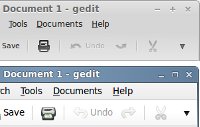 Go to Menu and click the "System Settings" icon.
Go to Menu and click the "System Settings" icon. - Click the Themes icon under Appearance.
- Select a theme from the list for the desktop and match it with the Windows borders, Icons, Controls and Mouse Pointer you like.
Manage Workspaces
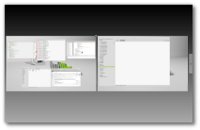 Linux Mint creates two workspaces by default, but you can add more and manage your workspaces pretty easily in several ways:
Linux Mint creates two workspaces by default, but you can add more and manage your workspaces pretty easily in several ways:
- Go to a workspace: get your mouse cursor to the top-left corner of the screen (aka "hot corner" or "Expo") to show all workspaces, then click a workspace to jump to. (The hot corner can be enabled via System Settings > Preferences > Hot Corners and check "Hover enabled".)
- Open an application in a workspace: mouse over a workspace to see all applications in the workspace (aka "Scale"), then select an application.
- Move an application from a workspace to another: drag an application and drop it to another workspace.
- Add a workspace: press the "+" sign on the right when in Expo mode.
- Edit a workspace title: click it in Expo mode.
- Remove a workspace: mouse over a workspace and click the "x" button when in Expo mode.
These shortcuts are also helpful:
- Ctrl+Alt+Up goes to Expo.
- Ctrl+Alt+Down goes to Scale.
- Ctrl+Alt+Left/Right switches to the left/right adjacent workspace.
- Ctrl+Alt+Shift+Left/Right moves the active window to the left/right adjacent workspace.
Hide Drive Icons on the Desktop
In addition to the Computer and Home icons, Linux Mint adds an icon to the desktop for every removable drive that you attach to your system. The icons can be hidden by these steps:
- Go to Menu and click the "System Settings" icon.
- Click the Desktop icon under Preferences.
- Turn off the Desktop icons for Computer, Home and Mounted volumes if you don't want to show them on the desktop, then close the window.
The drive icons as well as computer and home icons would then disappear from the desktop, simple as that. Remember that you can always access the drives from Menu > Files.
Change Wallpapers Automatically
Linux Mint 17.1 and 17.2 allow you to change the desktop background or wallpaper at a fixed time interval via System Settings > Appearance > Backgrounds, but if your system doesn't come with it or you need more choices, try Wally.
-
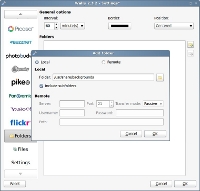 Install Wally from the Ubuntu Apps Directory if the application is not in your system.
Install Wally from the Ubuntu Apps Directory if the application is not in your system. - Press Alt-F2, type wally and press Enter to run it.
- Right-click the Wally icon on the system tray or the notification area, select Settings.
- Click "Folders" in the left column, then add /usr/share/backgrounds to the Folder box and tick "Include subfolders".
- Click "Settings" in the left column, then tick "Play automatically on application starts". You can also check the option to disable splash screen and auto quit if you wish.
- Set the application to auto start, using this tip Auto Start Up an Application (as Wally's option to "Start automatically when system starts" being disabled).
Your wallpaper on the desktop will automatically change following these basic settings when you log back in the system (or right click the Wally icon on the system tray and select "Play").
Customize Keyboard Shortcuts
Keyboard shortcuts are preset in the system, but you can add new ones or change them easily. For instance, you can add a new keyboard shortcut to the text editor Gedit, like below.
- Go to Menu > System Settings > Keyboard.
- Under the "Shortcuts" tab, click the "Add custom shortcut" button.
- Enter gedit to both the Name and Command boxes, then click the Add button.
- Click on the unassigned row (unassigned is then changed to New accelerator... or Pick an accelerator).
- Press a new key combination, e.g. Ctrl+Alt-g. And the shortcut is ready for use!)
Terminate Unresponsive Programs
Xkill is part of the X11 utilities pre-installed in Linux Mint and a tool for terminating misbehaving X clients or unresponsive programs. You can easily add a shortcut key to launch xkill with the steps below.
- Go to Menu > System Settings > Keyboard.
- Under the "Shortcuts" tab, click the "Add custom shortcut" button.
- Enter xkill to both the Name and Command boxes and click the Add button.
- Click on the unassigned row (unassigned is then changed to New accelerator... or Pick an accelerator).
- Press a new key combination, e.g. Ctrl+Alt-x.
Xkill is ready for use. Press the above key combination to turn the cursor to an X-sign, move the X-sign and drop it into a program interface to terminate the unresponsive program, or cancel the X-sign with a right-click.
Re-start System without Rebooting
If you press Ctrl+Alt+Delete, Linux Mint brings you a menu to log out your system. But for some reason you might encounter that the system freezes, the mouse cursor can't move, neither pressing Ctrl+Alt+Delete can work.
Remember that there's a shortcut key Ctrl+Alt+Backspace that can bring you back to the log-in screen immediately without the need to reboot the system. That's a time saver.
Set a Default View in File Manager
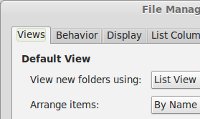 Windows Explorer allows for users to set a default view to all folders. In almost the same way, Linux Mint's File Manager allows for these settings:
Windows Explorer allows for users to set a default view to all folders. In almost the same way, Linux Mint's File Manager allows for these settings:
- Go to "Menu" and click the Files icon.
- At the top of the File Browser, click "Edit" and "Preferences".
- Under Default View, change "Icon View" to "List View", to see more details in columns.
Other various settings, such as single or double click to open items, icon captions, list columns and preview files can be done in the same window as well.
Change a Folder Icon
When running the File Manager, you will see that the folder icons are predetermined by the theme you set. If you wish to change a folder icon to another for it to stand out from the system-wide icons, follow these steps:
- In the File Manager, right click a folder icon, select Properties.
- Under the Basic tab, click the icon image to open up the "Select Custom Icon" window.
- In the Location field, type /usr/share/icons, press Enter. (You can hide or unhide the Location field by clicking the Edit button on the top-left of the window.)
- Browse and select an icon you want.
- Click the Open button on the bottom-right of the window to confirm.
Note: You can change your custom folder icon back to the default by clicking the "Revert" button in the "Select Custom Icon" window at Step 2 above.
Create an Advanced File Manager
In the Mint file system, you can use File Manager to browse most files but can only write files in your home folder /home/your_name and its sub-folders such as Desktop and Documents. If you have to rename a folder or write files outside of your home folder using the File Manager, you won't be able to but you can create an advanced file manager for this purpose.
- Go to Menu > System Settings > Keyboard.
- Under the "Keyboard shortcuts" tab, click the "Add custom shortcut" button.
- Enter a name such as Advanced File Manager in the "Name" box.
- Enter gksu nemo to the Command box, then click the Add button.
- Click on the unassigned row (unassigned is then changed to New accelerator... or Pick an accelerator).
- Press a new key combination, e.g. Ctrl+Alt-n.
Now you can easily access the Advanced File Manager by pressing the shortcut key you assigned. But be careful since you can use it to delete or change any files on your system.
Set Sound Output
If you use a PC with an integrated audio device and it has no sound when playing a media file on a player, try these simple steps to set Sound Preferences for your PC. It works for me for the audio device I have.
- Go to Menu > System Settings > Sound to bring up the Sound window.
- Under the Output tab, change the setting to Built-in Audio, Analog Output or other available items from the list.
- Click "Test Sound" to check if it works.
As the items available from the list might differ depending on the hardware devices detected by the system, you might want to try other items in the menus to see if they work for your devices.
Change or Disable Login Sound
Each time when you login to Linux Mint, it may play a login sound depending on the setting. If you don't like how it behaves, you can easily enable or disable a sound, or change it to your favorite sound.
- Go to Menu > System Settings > Sound.
- Under the "Sound Effects" tab, with the item "Starting Cinnamon" having checked, select a sound you like and click the "Play" button to try the sound if needed.
- If you want to disable the log-in sound, uncheck "Starting Cinnamon"
Log out and log back in to check the new setting for login sound. Similarly you can try out sounds for other actions.
Install Extra Fonts
Do you prefer Windows TrueType fonts to the default fonts installed by Linux Mint? The mscorefonts package containing most Microsoft fonts can be installed and configured easily in a few steps below:
-
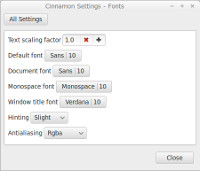 Go to Menu > Terminal.
Go to Menu > Terminal. - Paste sudo apt-get install ttf-mscorefonts-installer into the Terminal (by pressing Ctrl-Shift-V in the Terminal after copying the highlighted code).
- When prompted, use the arrow left/right keys to navigate and agree to the EULA license terms for the install.
- Go to Menu > System Settings > Fonts.
- Click each of them, pick a font, such as Verdana, and size to configure for window title and so on.
Besides this, you can run an application such as Font-Manager to view, install, remove fonts and so on.
Install Screenlets
Screenlets are small applications to represent things such as sticky notes, clocks, calendars around on your desktop. You can launch a pre-installed screenlet from Screenlets manager, or install a new one into the manager for launching it. Here are the steps for installing and launching a screenlet, for example, WaterMark System Information.
-
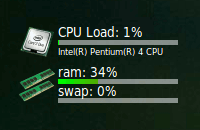 Install Screenlets manager if it has not been added from the Ubuntu Apps Directory. (Note: You can also install it via Software Manager by searching for this application.)
Install Screenlets manager if it has not been added from the Ubuntu Apps Directory. (Note: You can also install it via Software Manager by searching for this application.) - Download the screenlet "WaterMark System Information" to a folder.
- Press Alt-F2, type Screenlets into the box and press Enter to run the manager.
- Click Install, select Install Screenlet and click OK.
- Browse to the folder, select the file downloaded and click "Open" to install the screenlet into the Screenlets manager.
- Select the screenlet "WaterMark" and click "Launch/Add". (Tips: you can add more than one WaterMark screenlet and set it to display other system information.)
Install Oracle Java Packages
Linux Mint uses OpenJDK by default, but some web services might need the Oracle Java Runtime Environment (JRE) to be installed for running the services properly. If you would like to get the proprietary Oracle Java package for your system, you can download and install it with the steps below:
- Go to Menu > Terminal.
- Enter sudo add-apt-repository ppa:webupd8team/java to add the partner repository.
- Enter sudo apt-get update to update the source list.
- Enter sudo apt-get install oracle-java8-installer
At any time, you can check the Java version you're using and configure it when necessary:
- Enter sudo java -version to check the version of the Java used in the system.
- Enter sudo update-alternatives --config java to choose the default Java for use in the system.
Add More Useful Software
Linux Mint's Software Manager lets you search and get free software. You can go to Menu > Software Manager, type in an application to search, download and install it. You can also go to Menu > Administration > Synaptic Package Manager, type in an application name to search and install a software package from the repositories.
Besides this, you can also go to Ubuntu Apps Directory to find the software products you need. If you like a product on the Directory, just click the orange download button and it opens up in a package manager for you to confirm the install.
Alternatively, you can get the latest freeware applications by clicking the Install this now button from the GetDeb Repository after the getdeb package is installed with the instructions given.
See also our Best Free Software for Linux.
Auto Mount Drives at System Startup
Linux Mint is capable of reading and writing files stored on Windows formatted partitions using NTFS file system, but partitions must be 'mounted' before they can be accessed. With these steps, you can auto mount the drives or partitions without the need to manually mount them for access each time you start up the system.
- In the Terminal, enter sudo blkid to get the UUID (Universally Unique Identifier) of the partition you want to mount.
- Enter sudo mkdir /media/ntfs to create a mount point
-
Enter gksu gedit /etc/fstab and add the following line in the fstab file:
UUID=1234567890123456 /media/ntfs ntfs rw,nosuid,nodev,noatime,allow_other 0 0 - Replace the above 16-digit number with the UUID you've got from step 1, then click 'Save'.
Restart the system and check if the partition is mounted.
![]() To identify disk partitions by label, either use sudo blkid or ls /dev/disk/by-label -g in the Terminal. To view partition sizes and file systems, enter sudo fdisk -l. Disks app mentioned in "Name or Label a Partition" also gives you a glance of device numbers, partition types, sizes and labels.
To identify disk partitions by label, either use sudo blkid or ls /dev/disk/by-label -g in the Terminal. To view partition sizes and file systems, enter sudo fdisk -l. Disks app mentioned in "Name or Label a Partition" also gives you a glance of device numbers, partition types, sizes and labels.
Manually Mount a USB Drive
A USB storage device plugged into the system usually mounts automatically, but if for some reasons it doesn't automount, it's possible to manually mount it with these steps.
- Go to Menu > Terminal.
- Enter sudo mkdir /media/usb to create a mount point called usb.
- Enter sudo fdisk -l to look for the USB drive already plugged in, let's say the drive you want to mount is /dev/sdb1.
-
Enter sudo mount -t vfat /dev/sdb1 /media/usb -o uid=1000,gid=100,utf8,dmask=027,fmask=137 to mount a USB drive formatted with FAT16 or FAT32 system. OR:
Enter sudo mount -t ntfs-3g /dev/sdb1 /media/usb to mount a USB drive formatted with NTFS system.
To unmount it, just enter sudo umount /media/usb in the Terminal.
Name or Label a Partition
The File Manager shows the root directory as File System for your Mint system partition. If you have other partitions (or volumes), it shows them as xx GB Volume if they’re not named or labelled.
Using Disks app is one of the effective ways to name a partition easily:
-
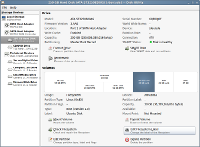 Go to Menu > Preferences > Disks
Go to Menu > Preferences > Disks - Select the item Hard Disk.
- In the Volumes section, click a partition you want to label.
- Click the 'More actions' button below the Volumes section then select "Edit Filesystem..."
- In the Label box, enter a name, e.g. Data-Disk, and click Apply.
The File Manager should now show the partition label, such as Data-Disk, instead of xx GB Volume. This tip is for naming a partition using the application; use other advanced features such as format, edit or delete partition with caution as they can delete data on your disk.
Auto Start Up an Application
In Windows, you can place a program shortcut in a startup folder for running a program automatically when the system starts. In Linux Mint, you can do the same in this way:
-
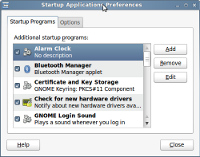 Go To Menu > Preferences > Startup Applications
Go To Menu > Preferences > Startup Applications - Click the "Add" button. (Note: in Linux Mint 17.2, you can then choose an application right away, or continue the steps below after selecting Custom Command)
- Name a program.
- Click the "Browse" button and navigate to File System > usr > bin, where programs are usually installed.
- Select a program, click the "Open" button followed by the "Add" button.
The above program will then be listed in additional startup programs. Check if the program runs automatically by logging out and back to the system.
Change a Login Screen and Theme
Linux Mint offers you a Mint Display Manager (MDM) to configure a login session. You can use it to change a login screen or a theme you like in a few steps:
-
 Go to Menu > Administration > "Login Window" to open this window "Login Window Preferences".
Go to Menu > Administration > "Login Window" to open this window "Login Window Preferences". - Under the Theme, select a built-in theme, then log out and back in to try a new log-in screen.
Moreover, you can download a similar theme for installation. For example:
- Download a theme from gnome-look.org, such as Relaxing Water for the GDM style.
- Drag and drop the downloaded theme file (.tar.gz) to the MDM under the "Theme".
- Click "Install", select this new theme then close the MDM.
- Log out and back in to enjoy a new login session.
Change Default Boot Options
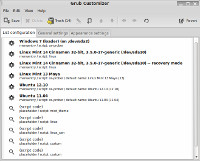 After full installation, Linux Mint is commonly set to be the default operating system to boot up if no key is pressed within a few seconds on a multi-boot system. You might want to set your preferred operating system to boot up by default. This can be done easily with Grub Customizer.
After full installation, Linux Mint is commonly set to be the default operating system to boot up if no key is pressed within a few seconds on a multi-boot system. You might want to set your preferred operating system to boot up by default. This can be done easily with Grub Customizer.
Press Ctrl-Alt-T to call up Terminal, copy following codes and paste (Ctrl-Shift-V) them inside the Terminal to install Grub Customizer.
- sudo add-apt-repository ppa:danielrichter2007/grub-customizer
- sudo apt-get update
- sudo apt-get install grub-customizer
After installation, run Grub Customizer to set the default boot options with the following steps.
- Press Alt-F2, type grub-customizer into the box and press Enter to run it.
- Under the "General Settings" tab, select the default entry you like to boot up from the drop-down menu.
- Adjust the timeout value if needed, then press the Close button and the Save button.
Avoid changing timeout to 0 seconds if you need to select a system to boot up from a multi-boot menu.
Clean Up Boot Menu
Each time when Linux Mint updates to a new Linux kernel, the old one is left behind and the boot menu gets longer. If your new Linux kernel works well, it's safe to clean up the boot menu. Do take these steps carefully as incorrectly hiding the items can make your system unbootable. You can check the Linux kernel version you're running by entering this command line uname -r into the Terminal.
To clean up the boot menu, it's pretty straightforward with Grub Customizer used in the tip above.
- Press Alt-F2, type grub-customizer into the box and press Enter to run it.
- Remove the entries you want to hide from the boot menu, or restore the removed entries if you wish.
- Click the Save button.
Auto Shutdown the System
A simple command can be entered in the Terminal to schedule a time for the system to shut down.
- Go to Menu > Terminal.
-
Enter sudo shutdown -h +m (replace m with the number of minutes, e.g. +60).
OR: enter sudo shutdown -h hh:mm (replace hh:mm with the time on the 24hr clock, e.g. 23:15). - Enter password and minimize the Terminal window.
The system will then shut down within the minutes or at the time specified. To cancel a scheduled time, enter sudo shutdown -c in the Terminal.
Alternatively, you might want to download and install GShutdown, which is a GUI program for scheduling a time to shutdown the system.
Related Links
- Tips and Tricks for Linux Mint after Installation [Mint 17 & 17.2 - MATE Edition]
- Tips and Tricks for Ubuntu after Installation [Ubuntu 14.04 to 15.04]
- Easy Way to Install Ubuntu - from within Windows
- Best Free Software for Linux
- Tips and Tricks for Linux Mint after Installation [Mint 13 to 16 - Cinnamon Edition]
- Tips and Tricks for Linux Mint after Installation [Mint 13 to 16 - MATE Edition]
Editor
This category is maintained by volunteer editor Jojo Yee. Registered members can contact the editor with comments or suggestions by clicking here.
You can visit the Google+ profile page of Jojo Yee here.
Back to the top of the article
 We are looking for people with skills or interest in the following areas:
We are looking for people with skills or interest in the following areas:

Comments
Thank you for the article. There aren't that many articles explaining how to customize a Linux Mint Cinnamon Desktop, this is very helpful in that respect. Can you explain how to install and change new window borders, icons and controls for a customized look of the desktop?
Great consolidation of tips and tricks in a very concise but clear series of steps with suggestions. My only suggestion would be to yell at the mint designers/changers who change the menu choices regularly. For instance, the menu choice referred to often is "system settings", but that is nowhere to be found. it has been changed to "preferences". I like the change, but the tips need some editing to show the new choice names for the newcomers who cannot figure it out... :)
Thanks for your comments jim7fl. System Settings is directly available in the left most column of the Menu. It is one of the favorite icons by default unless you have removed it.
By the way, I've now updated this review to reflect the changes in the latest version Linux Mint 17.2.
Everything was splendid with Cinnamon except getting a dark or black window.
It turns out that it is easy by going to the Themes under System Settings and clicking on "Add/remove desktop themes" and then entering words like "black" "dark" "midnight" etc.
Currently, I'm using "Black Out" for Desktop, and "Zorba-black" for Controls and Window Borders.
]
For me to switch from Xubuntu to Mint Cinnamon was like a leap in faith.
For those like me who have the cheap (US $199) Acer Chromebook, you can get the tailored LM Cinnamon ISO from HughGreenBug's website.
Amazingly, Cairo-Dock works just fine in this Chromebook.
Since my screen size is rather small, I find it more comfortable to not use Cairo-Dock.
The AwOken Icon theme is worth testing out if you crave a dark theme.
Great job, clear and to the point.
You might want to add one more tip concerning pinning a group of home>documents>text file to the panel?
I recently had this feature and lost it somehow. When I minimized my group of document text files, they appeared as one tab on the panel. Within that one tab when clicked on the panel, (menu bar) it opened the last file I was looking at along with all the other files open in tab form along the top of the bar listing all open previous text files.
The system will then shut down within the minutes or at the time specified. To cancel a scheduled time, enter sudo shutdown -c in the Terminal.
imran
my personal favorite when i'm in the terminal is "sudo shutdown now" You had better be prepared after you enter the password, you will NOT get a chance to save any open files.... However it is a great command for when you have to leave right now and do not want to wait for suspend of hibernate before you head out the door.
Useful article Jojo Yee. Thanks!
Xubuntu (or other distros with Xfce) worked well for me for years until I read some good reviews about the Mint distro discussed here and decided to test it out. It's been going on a week now and I am lovin' it.
LM has come a long way from years ago when it was not much more than a polished version of Ubuntu, IMO.
Thank you, Jojo Yee. I'm looking for exacting, step by step, instructions for upgrading my Linux Mint 13, 64 bit to LM17 or 17.1
Thank you, Doug
That's too many versions to upgrade. Better off saving all your data (you do that anyhow, right?) and nuke it. I just keep a list of apps and install new versions after upgrading. Download the latest Mint, install in the partition that had the old Mint. If you have a separate /home partition you won't even have to reload your data. This avoids a lot of problems, in fact Mint used to insist on reloading for every new version, but now you can upgrade one level at a time.
I'm surprised nobody has posted a comment yet.
This is probably the most exhaustive hacking tip for LinuxMint 17 yet!
A definite keeper! :)
Over a year later, I cannot resist. This is an excellently written clear and concise set of easily understood instructions which make the arcane and esoteric understandable to us common folks. :)